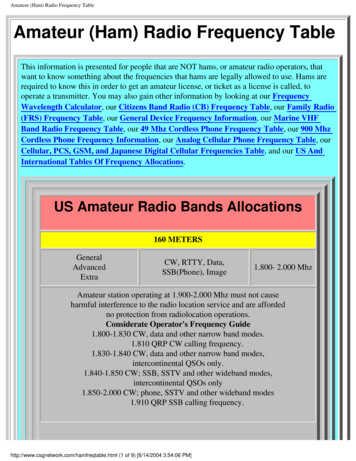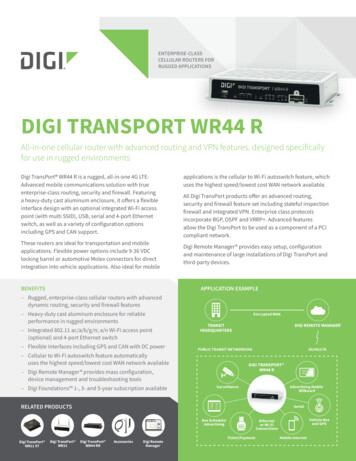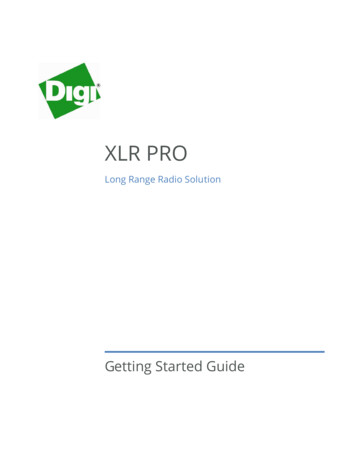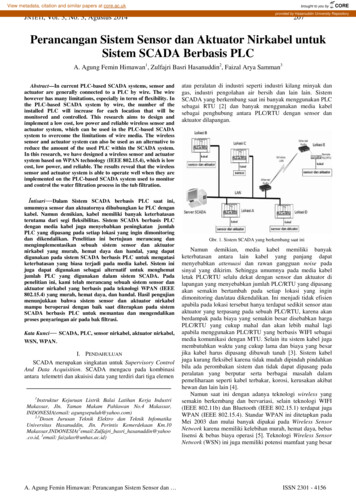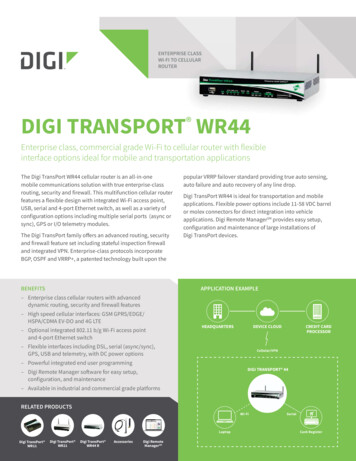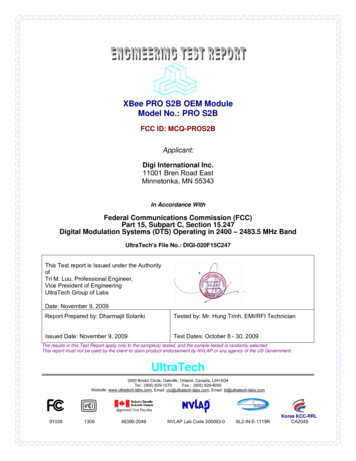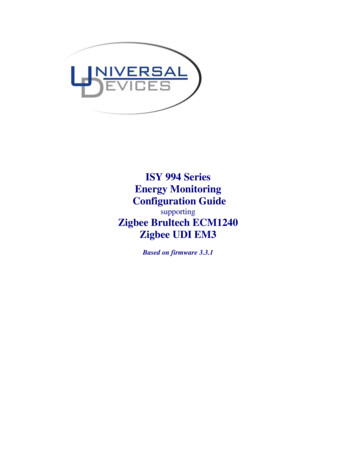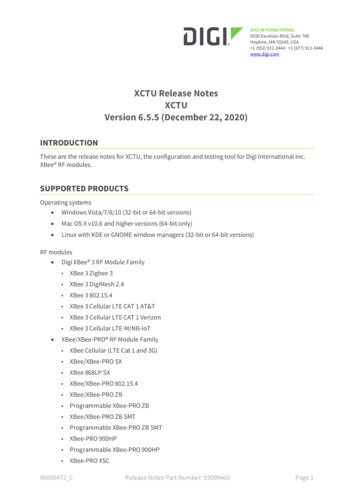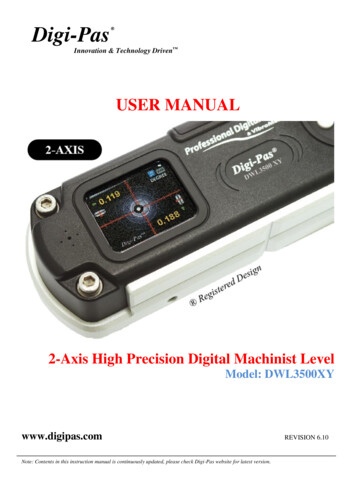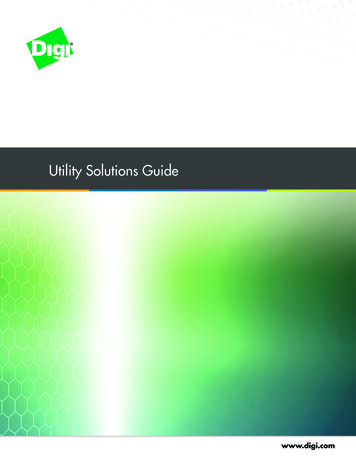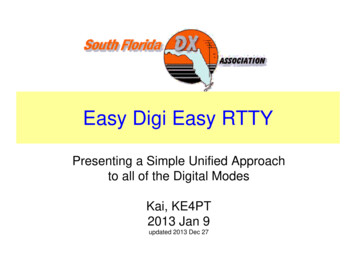
Transcription
Easy Digi Easy RTTYPresenting a Simple Unified Approachto all of the Digital ModesKai, KE4PT2013 Jan 9updated 2013 Dec 27
Easy Digi Easy RTTYBased on “Easy Digi Easy RTTY Workshop”presented by KE4PT and N4IEW, 2012 August 18Easy Digi in three easy steps:1. Connect two simple cables (plus antenna)2. Configure the radio and computer3. Configure digital mode software (as many asyou want)Details at the endKE4PT: 2013 Dec 272
Why “The Easy Way”?Subject: [MMTTY] RigBlaster Advantage on FSK usingMMTTY?Date:Tue, 08 Jan 2013 mm:hh:ss -0000From:rll## W#2### @gmail.com Reply-To: MMTTY@yahoogroups.comTo:MMTTY@yahoogroups.com“I have seen a lot of talk but few solutions. Is there anyonewho has been successful in configuring the RigblasterAdvantage with MMTTY to generate FSK? If so, how didyou do it? Please be specific.(Rig TS570 and Win 7 32 bit)”Thanks, Rob, W#2###KE4PT: 2013 Dec 273
Why Digital Modes? Almost all DXpeditions use at least RTTY Many DX stations now operate PSK31 andJT65, future will include JT9 modes DXCC counts all digital modes equally THERFORE: All digital-modes should beequally easy and convenient to operateKE4PT: 2013 Dec 274
One Simple Cable ConnectsComputer and Sound CardUSB conducts a digital signal:Computer does digitalmode encode and decode (PSK, RTTY, SSTV, JT9,JT65 etc.)Computer provides modesoftware and softwaredefined filtersThe computer passesDIGITIZED signals and 5 VDC power to the externalSignalink-USB sound cardKE4PT: 2013 Dec 275
One Simple Cable ConnectsSound Card and RadioSound card must RFand DC isolate radioand computerAnalog signal cableto radio(important!)Converts digitizedsignals fromcomputer to analogfor radioGenerates PTT andanalog signal fortransmissionKE4PT: 2013 Dec 276
One Simple Cable to AntennaRadio ALWAYS in upper SSBor upper Digital mode [U-DIG]antennaRadio audio pass band is“last IF” for digital signals,radio IF filter is “roofing filter”Computer is “software definedradio” inside the roofing filter(audio) pass bandRadio frequency dial is “zeroHertz” on the software “waterfall” spectrum displayKE4PT: 2013 Dec 277
Works equally well for All digi-modesUSB digital signal cableComputer: Digipan MMTTY JT65-JT9 SSTV, etc.Analog signal cableSignalink-USB: conditions signals isolates computerand radio: RF & DCKE4PT: 2013 Dec 27antennaRadio: Upper Digi/SSBfor all digi-modes “Last IF”, tunewith radio dial8
It’s so simple an Android can do it31KPS TTYR QST – MAY 2012interfaceFT- 8 1 7radioidAndro nephoSmartKE4PT: 2013 Dec 279
Just as Simple at Any StationYour laptopcomputerKE4PT: 2013 Dec 27Cable to IC-756pro-III mic jackor to accessory jack10
PSK31 and RTTY signalson ‘The Waterfall’Radio dial1,500 Hz offsetfrequency from dial frequencyPSK31 signal: 1500 Hztime axisRTTY “space”: 1415 HzRTTY “mark”: 1585 HzSSB filter audio pass band: 300 to 2,800 HzKE4PT: 2013 Dec 27Hint: You may select any filteryour radio supports, then “IFshift” to center on the signal11
Additional Digital ModesYou can add as many digi modes as youwant, just find the software:– JT65, JT9, WSJT-X– SSTV– PSK– RTTY etc. The radio-soundcard-computer togetheroperate like a software defined radioKE4PT: 2013 Dec 2712
Why use Digi Modes?During my quest for WAS Triple Play Award, I noticed that 30All HF digitalmodes outperformSSB – by a lot!Some HF digitalmodes outperformCW – by a lot!20Link performancerelative to CW10dB0PSK31 ( 7 dB)CW(0 dB ref)RTTY ( –4 dB)–10FM ( –14 dB)SSB ( –17 dB)–20–30From:JT65 ( 25 dB)AM ( –27 dB)K. Siwiak, KE4PT and B. Pontius, N0ADL, How much “punch” can you get fromdifferentoperatingmodes?KE4PT:2013Dec(QST27 Dec 2013 pp 30-32) [corrected here]13
Digi-modes have high link margin!CW 1AM1/16SSB1/6FM1/4RTTYPSK31Range compared to CW range2/3x2x 12JT65From:K. Siwiak, KE4PT and B. Pontius, N0ADL, How much “punch” can you get fromdifferentoperatingmodes?KE4PT:2013Dec(QST27 Dec 2013 pp 30-32) [corrected here]14
The Future includes more Digital New modes springing up constantly DX stations adopting high performancedigi modes You don’t need to change any hardwareor radio settings to adopt a new HFdigital mode: it’s all software!KE4PT: 2013 Dec 2715
Wrap UpThanks for your kind attention Latest Presentation at:http://SFDXA/– follow the presentations linkKE4PT: 2013 Dec 2716
DETAILS FOLLOWKE4PT: 2013 Dec 2717
Configuring the Radio and Computer The radio is ALWAYS set to upper single sidebandor upper digital mode [U-DIG], but NOT nativeRTTY mode and NOT lower SSB– Choose the dial frequency (displays the suppressedcarrier upper SSB or U-DIG mode frequency)– All digi action is in audio pass band 300 and 2800 Hz Configure Computer external sound card Sound card connects to, and RF isolates, radio andcomputer IMPORTANT: Set your transmitter power level tono more than 90–95% of maximum PEP!KE4PT: 2013 Dec 2718
Setting up Digipan for PSKConfigure Digipan PSK31 Software First:READ the Digipan and Signalink Guidelines!!!1. Start the Digipan application2. configure personal data call name QTH3. configure soundcard “USB audio codec” for bothTX and RX – IMPORTANT: read Signalink-USB Guidefor sound card audio levels4. configure soundcard sample rate 120005. [use macros as you like]Done!! – tune to PSK frequencies and QSOKE4PT: 2013 Dec 2719
Setting up MMTTY for RTTYConfigure MMTTY software [READ the HELP files!]1.2.3.4.Start MMTTYMARK 830 Hz (actually this is the SPACE tone)Shift 170 Hz, select type “rev”option setup demodulator “reverse” “HAM default830” and “170”, press HAM then OK5. option setup decode 45.45 baud, 5-bit baudot6. option setup soundcard “USB audio codec” foreach, TX and RX – IMPORTANT: read Signalink-USBGuide for sound card audio levels7. option setup misc sample rate 12000Done!! – tune to RTTY frequencies and QSOYour “spot” frequency is radio dial 170 MARKFor “split” operation do same as you would for SSB!KE4PT: 2013 Dec 2720
Add new MARK / SPACE in MMTTYThe mmtty.ini file must be edited, using a TEXT editor:[SoundCard]SampFreq 1.200000e 04TxOffset 0.000000e 00 Actually “Space” in “rev”Add 830 and 1415, to list[ComboList]Mark 2125,1415,1330,915,830Shift 23,85,160,170,182,200,240,350,425,850Baud 22,45,45.45,50,56,75,100,110,150,200,300This change allows SPACE 830 MARK 1000, or for 60m band, select “1415” so Mark and Space at1500 Hz 85 Hz as required by NTIA/FCC.KE4PT: 2013 Dec 2721
Operating on the 60m band Set the radio to 60 m band SSB suppressedcarrier frequency (the same way you operateSSB) – (radio in U-DIG for FT-817) FCC and NTIA require digi modes operate at thecenter of the channel, and require ability to listenin upper SSB– PSK: launch Digipan and click waterfall at exactly1500 Hz– RTTY: launch MMTTY; the ‘1415’ Hz tone places theMark and Space at 1500 Hz 85 Hz above thechannel SSB suppressed carrier frequencyKE4PT: 2013 Dec 2722
The Harmonious Choice My personal choice for "tone" offset on other HFbands is "915" plus 170 Hz That way the two tones appear /- 85 Hz eitherside of 1 kHz in upper SSB Easy to tune in RTTY stations using waterfalldisplays calibrated in kHz relative to the dialfrequency 915 and 1085 Hz tones are musically verynearly 3 semi-tones apart so they intone apleasant minor third interval – rather than the2125/2295 Hz screech2KE4PT: 2013 Dec 273 12 915 108823
Tone Pair Choices 830/1000 Hz– “Mark” equals dial frequency plus 1 kHz – easy spotting calculation 915/1085 Hz– straddles 1 kHz, intones a pleasant musical minor third interval 1415/1585 Hz– straddles 1.5 kHz – appropriate choice for 60 m band while operating in upper SSB or UDIG. Note that many receivers center their digital filters at 1500 Hz in digital mode 1830/2000 Hz– “Mark” equals dial plus 2 kHz – easy spotting calculation 2125/2295 Hz– traditional, useful if your receiver uses antique decoding equipment with fixed analogaudio tone filters based on 88 mH toroid coilCaution: in transmit most radios use the default SSB filter bandwidth no matter whatyou select for the receiving filter. The second audio harmonic of your chosen tonesshould be above the upper cut-off frequency of the transmitter SSB filter!KE4PT: 2013 Dec 2724
KE4PT: 2013 Dec 2726
Easy Digi Easy RTTY Based on "Easy Digi Easy RTTY Workshop" presented by KE4PT and N4IEW, 2012 August 18 Easy Digi in three easy steps: 1. Connect two simple cables (plus antenna) 2. Configure the radio and computer 3. Configure digital mode software (as many as you want) Details at the end
